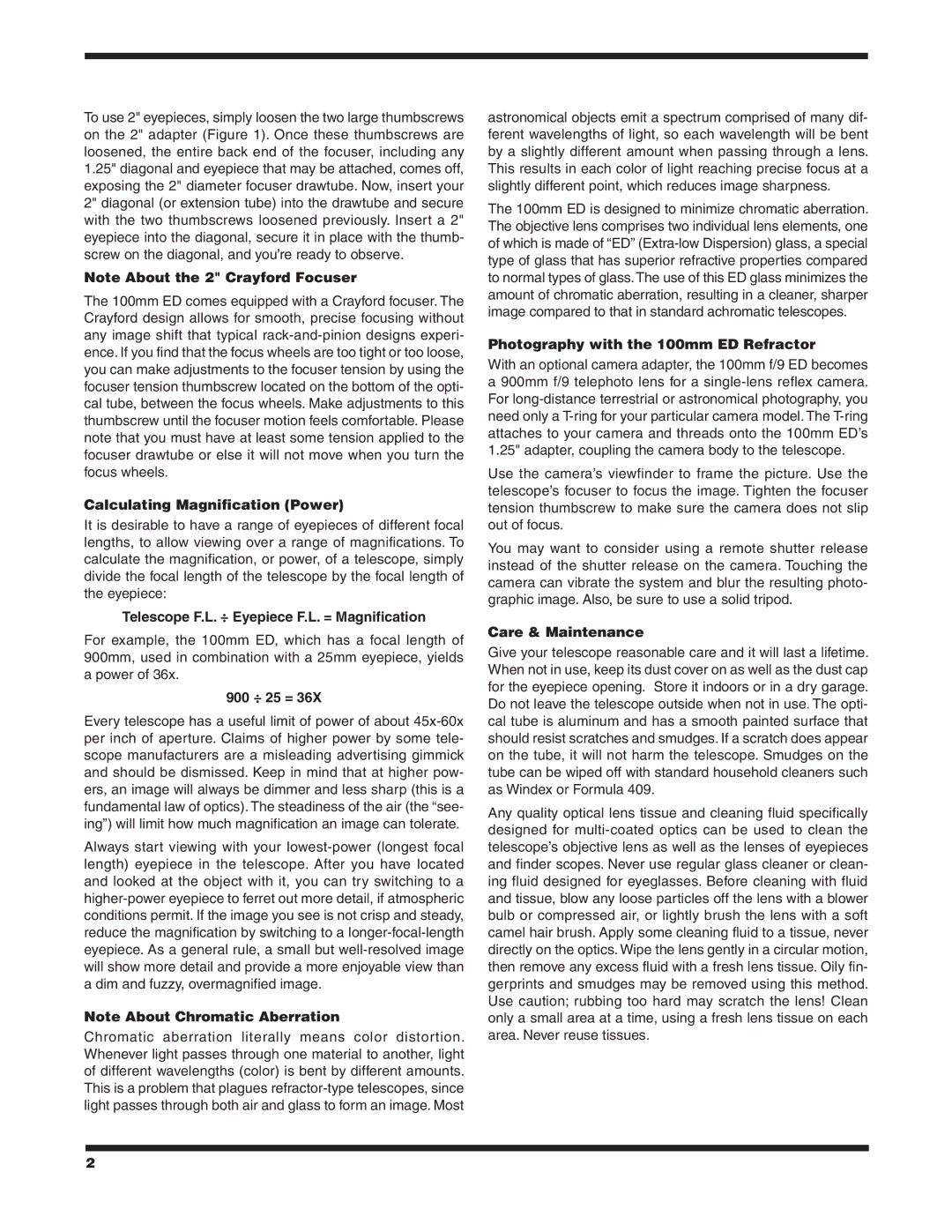To use 2" eyepieces, simply loosen the two large thumbscrews on the 2" adapter (Figure 1). Once these thumbscrews are loosened, the entire back end of the focuser, including any 1.25" diagonal and eyepiece that may be attached, comes off, exposing the 2" diameter focuser drawtube. Now, insert your 2" diagonal (or extension tube) into the drawtube and secure with the two thumbscrews loosened previously. Insert a 2" eyepiece into the diagonal, secure it in place with the thumb- screw on the diagonal, and you’re ready to observe.
Note About the 2" Crayford Focuser
The 100mm ED comes equipped with a Crayford focuser. The Crayford design allows for smooth, precise focusing without any image shift that typical rack-and-pinion designs experi- ence. If you find that the focus wheels are too tight or too loose, you can make adjustments to the focuser tension by using the focuser tension thumbscrew located on the bottom of the opti- cal tube, between the focus wheels. Make adjustments to this thumbscrew until the focuser motion feels comfortable. Please note that you must have at least some tension applied to the focuser drawtube or else it will not move when you turn the focus wheels.
Calculating Magnification (Power)
It is desirable to have a range of eyepieces of different focal lengths, to allow viewing over a range of magnifications. To calculate the magnification, or power, of a telescope, simply divide the focal length of the telescope by the focal length of the eyepiece:
Telescope F.L. ÷ Eyepiece F.L. = Magnification
For example, the 100mm ED, which has a focal length of 900mm, used in combination with a 25mm eyepiece, yields a power of 36x.
900 ÷ 25 = 36X
Every telescope has a useful limit of power of about 45x-60x per inch of aperture. Claims of higher power by some tele- scope manufacturers are a misleading advertising gimmick and should be dismissed. Keep in mind that at higher pow- ers, an image will always be dimmer and less sharp (this is a fundamental law of optics). The steadiness of the air (the “see- ing”) will limit how much magnification an image can tolerate.
Always start viewing with your lowest-power (longest focal length) eyepiece in the telescope. After you have located and looked at the object with it, you can try switching to a higher-power eyepiece to ferret out more detail, if atmospheric conditions permit. If the image you see is not crisp and steady, reduce the magnification by switching to a longer-focal-length eyepiece. As a general rule, a small but well-resolved image will show more detail and provide a more enjoyable view than a dim and fuzzy, overmagnified image.
Note About Chromatic Aberration
Chromatic aberration literally means color distortion. Whenever light passes through one material to another, light of different wavelengths (color) is bent by different amounts. This is a problem that plagues refractor-type telescopes, since light passes through both air and glass to form an image. Most
astronomical objects emit a spectrum comprised of many dif- ferent wavelengths of light, so each wavelength will be bent by a slightly different amount when passing through a lens. This results in each color of light reaching precise focus at a slightly different point, which reduces image sharpness.
The 100mm ED is designed to minimize chromatic aberration. The objective lens comprises two individual lens elements, one of which is made of “ED” (Extra-low Dispersion) glass, a special type of glass that has superior refractive properties compared to normal types of glass. The use of this ED glass minimizes the amount of chromatic aberration, resulting in a cleaner, sharper image compared to that in standard achromatic telescopes.
Photography with the 100mm ED Refractor
With an optional camera adapter, the 100mm f/9 ED becomes a 900mm f/9 telephoto lens for a single-lens reflex camera. For long-distance terrestrial or astronomical photography, you need only a T-ring for your particular camera model. The T-ring attaches to your camera and threads onto the 100mm ED’s 1.25" adapter, coupling the camera body to the telescope.
Use the camera’s viewfinder to frame the picture. Use the telescope’s focuser to focus the image. Tighten the focuser tension thumbscrew to make sure the camera does not slip out of focus.
You may want to consider using a remote shutter release instead of the shutter release on the camera. Touching the camera can vibrate the system and blur the resulting photo- graphic image. Also, be sure to use a solid tripod.
Care & Maintenance
Give your telescope reasonable care and it will last a lifetime. When not in use, keep its dust cover on as well as the dust cap for the eyepiece opening. Store it indoors or in a dry garage. Do not leave the telescope outside when not in use. The opti- cal tube is aluminum and has a smooth painted surface that should resist scratches and smudges. If a scratch does appear on the tube, it will not harm the telescope. Smudges on the tube can be wiped off with standard household cleaners such as Windex or Formula 409.
Any quality optical lens tissue and cleaning fluid specifically designed for multi-coated optics can be used to clean the telescope’s objective lens as well as the lenses of eyepieces and finder scopes. Never use regular glass cleaner or clean- ing fluid designed for eyeglasses. Before cleaning with fluid and tissue, blow any loose particles off the lens with a blower bulb or compressed air, or lightly brush the lens with a soft camel hair brush. Apply some cleaning fluid to a tissue, never directly on the optics. Wipe the lens gently in a circular motion, then remove any excess fluid with a fresh lens tissue. Oily fin- gerprints and smudges may be removed using this method. Use caution; rubbing too hard may scratch the lens! Clean only a small area at a time, using a fresh lens tissue on each area. Never reuse tissues.

